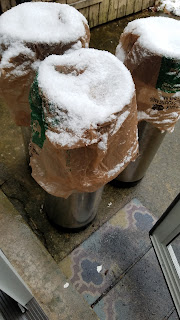 |
| Vent hood and storage shelf |
 |
| Fermentation chamber and sink with pegboard |
No, it's not particularly neat, but it seemed about as tidy as it was going to get.
Vent Hood
The contractors got the vent hood in, but come to find out that there's a minimum drop from the ceiling. As a result, the hood is a bit lower than I'd like (the controls are at about my eye level) but there's enough space between the hood and the table.
One Table Too Many
Speaking of the tables... I bought two of them. After assembling one, I realized there really wasn't room for the other. Given that the hood is pretty much in the corner, I really couldn't fit the other table in without losing tabletop space or making it a tight squeeze near the hood. The other one went into the laundry room for folding.
I had some 220V wiring moved from roughly where the ferm chamber is to the corner by the hood. Someday I plan to get a much more powerful induction burner and will need the extra voltage to make it happen.
Brew Sink
The sink went in with some difficulty. The plumbers had clearly never worked on a commercial sink before. They didn't install the 90-degree elbows behind the faucet, so they had to punch holes in the drywall to get the supply lines to make the bend. They also needed a ridiculous amount of pipe dope to make the connections. That got fixed tout suite.
The drain really confused them. I ordered a drain that closes by moving a lever. This drain added a few inches to the bottom and made plumbing the trap tricky. The eventually figured it out, but the damn thing leaks. I left the sink half-filled with water to soak off some bottle labels. I came back several hours laters to a puddle on the floor. That's going on the warranty punch list.
The faucet itself is .... meh. The aerator started rusting after about 2 months. More annoying is the cold-water valve. If I try to turn it on slowly - to fill a small glass with just a little bit of water - the valve makes a loud THUNK! and shuts off. Keep turning it and the water comes back on. It's a bother when I want a trickle of water. I guess its great if I'm trying to fill a mop bucket.
Pegboard
Seeing as I had a lot of free wall space around the sink, I installed a stainless-steel pot shelf up high and two Triton 22x18" white plastic pegboard panels in the corner. This would give me a place to hang tools and tubing. I also added a small Homak 12-drawer parts organizer to keep kegs parts at hand. The pegboard installed pretty easily when I used Triton's pegboard mounting kit. The anchors require a bit of drilling, but these pegboards aren't going anywhere.
Unfortunately, the distance between the organizer's mounting holes didn't match the pegboard's spacing. I drove two screws into the board and basically hung the parts drawer on them. Not ideal, but it works.
 |
| Installed panel (left) and anchor |
 |
| Drawer unit resting on screws driven into pegboard |
No More Brew Boxes
Previously, I kept a lot of my gear in two plastic totes: One for brew day (scale, thermometers, etc) and another for the kegs (wrenches, spare o-rings, etc.) I even wrote about making a brew day box a while back. Thing is, with the pegboard and parts drawers - nevermind a whole room dedicated to brewing - I really don't need the boxes anymore. Everything has a home now.




































